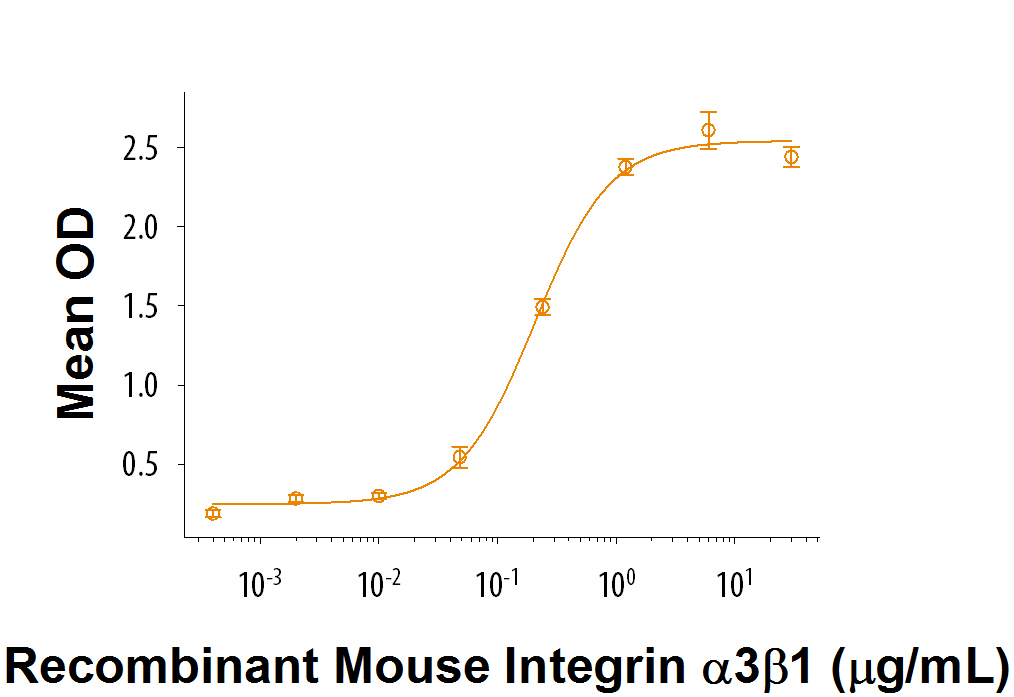Recombinant Mouse Integrin alpha 3 beta 1/VLA-3 Protein, CF
Recombinant Mouse Integrin alpha 3 beta 1/VLA-3 Protein, CF Summary
Product Specifications
ED50 = 150-900 ng/mL.
| Mouse Integrin alpha 3 (Phe33-Glu993) Accession # Q62470-1 | His-Pro | GGGSGGGS | Acidic Tail | 6-His tag |
| Mouse Integrin beta 1 (Gln21-Asp728) Accession # P09055-1 | His-Pro | GGGSGGGS | Basic Tail | |
| N-terminus | C-terminus |
Analysis
Product Datasheets
Carrier Free
CF stands for Carrier Free (CF). We typically add Bovine Serum Albumin (BSA) as a carrier protein to our recombinant proteins. Adding a carrier protein enhances protein stability, increases shelf-life, and allows the recombinant protein to be stored at a more dilute concentration. The carrier free version does not contain BSA.
In general, we advise purchasing the recombinant protein with BSA for use in cell or tissue culture, or as an ELISA standard. In contrast, the carrier free protein is recommended for applications, in which the presence of BSA could interfere.
9374-A3
| Formulation | Lyophilized from a 0.2 μm filtered solution in PBS. |
| Reconstitution | Reconstitute at 500 μg/mL in PBS. |
| Shipping | The product is shipped at ambient temperature. Upon receipt, store it immediately at the temperature recommended below. |
| Stability & Storage: | Use a manual defrost freezer and avoid repeated freeze-thaw cycles.
|
Scientific Data
 View Larger
View Larger
When Cultrex® Mouse Laminin-I (Catalog # 3400-010-01) is coated at 2 µg/mL, Recombinant Integrin a3 beta 1/VLA-3 (Catalog # 9374-A3) binds with an ED50 = 150-900 ng/mL.
Reconstitution Calculator
Background: Integrin alpha 3 beta 1/VLA-3
Integrin alpha 3 beta 1, also known as VLA-3 (Very Late Antigen 3), is a member of the integrin family, beta 1 subfamily, of cell membrane adhesion molecules (1-3). It is a non-covalent heterodimer composed of two type I transmembrane glycoprotein subunits, a 130-150 kDa alpha 3 (CD49c) subunit and a 130-140 kDa beta 1 (CD29) subunit. Integrin alpha 3 only associates with the beta 1 subunit. It is synthesized as a 1051 amino acid (aa) precursor that undergoes proteolytic cleavage to generate a disulfide-linked 110 kDa, 842 aa extracellular heavy chain and a 30 kDa, 176 aa TM/cytoplasmic light chain (1, 4, 5, 6). The heavy chain contains seven 60 aa repeats that fold into a propeller-like structure (7). Sequences involving the first three repeats are associated with ligand binding (1). Mouse alpha 3 heavy chain is 88% aa identical to human heavy chain. Unlike the alpha 3 subunit, the mouse beta 1 subunit does not undergo proteolytic cleavage (8). The molecule contains a 708 aa extracellular region, a 23 aa TM segment, and a 47 aa cytoplasmic domain. The extracellular region contains one von Willebrand factor-like A domain and four cysteine-rich repeats. Mouse beta 1 extracellular domain shares 93% and 98% aa sequence identity with human and rat beta 1, respectively. Integrin alpha 3 beta 1 is known to bind fibronectin, collagen, and laminin-1, 5, 8, 10 and 11 (1). It also binds tetraspanins such as CD9, CD63 and CD151. CD151 binding may actually stabilize it, enabling it to bind to additional factors (9).
- Tsuji, T. et al. (2004) J. Membr. Biol. 200:115.
- Gu, J. and N. Taniguchi (2004) Glycoconj. J. 21:9.
- Kreidberg, J.A. (2000) Curr. Opin. Cell Biol. 12:548.
- Takada, Y. et al. (1991) J. Cell. Biol. 115:257.
- de Melker, A.A. et al. (1997) Lab. Invest. 76:547.
- Krokhin, O.V. et al. (2003) Biochemistry 42:12950.
- Springer, T.A. (2002) Curr. Opin. Struct. Biol. 12:802.
- Argraves, W.S. et al. (1987) J. Cell Biol. 105:1183.
- Nishiuchi, R. et al. (2005) Proc. Natl. Acad. Sci. USA 102:1939.
Citations for Recombinant Mouse Integrin alpha 3 beta 1/VLA-3 Protein, CF
R&D Systems personnel manually curate a database that contains references using R&D Systems products. The data collected includes not only links to publications in PubMed, but also provides information about sample types, species, and experimental conditions.
2
Citations: Showing 1 - 2
Filter your results:
Filter by:
-
An innovative strategy to identify new targets for delivering antibodies to the brain has led to the exploration of the integrin family
Authors: C Cegarra, B Cameron, C Chaves, T Dabdoubi, TM Do, B Genêt, V Roudières, Y Shi, P Tchepikoff, D Lesuisse
PLoS ONE, 2022-09-15;17(9):e0274667.
Species: Mouse
Sample Types: Cell Lysates
Applications: ELISA Capture -
Synthetic integrin-binding immune stimulators target cancer cells and prevent tumor formation
Authors: M Brehs, AJG Pötgens, J Steitz, K Thewes, J Schwarz, AC Conibear, M Bartneck, F Tacke, CFW Becker
Sci Rep, 2017-12-14;7(1):17592.
Species: Mouse
Sample Types: Recombinant Protein
Applications: Surface Plasmon Resonance
FAQs
-
What is the amino acid sequence of the acidic and basic tails?
Acidic and basic tails are added to the protein to help facilitate optimal activity. While we generally include sequence information on the product datasheet, the sequences of these tails are considered confidential information.
Reviews for Recombinant Mouse Integrin alpha 3 beta 1/VLA-3 Protein, CF
There are currently no reviews for this product. Be the first to review Recombinant Mouse Integrin alpha 3 beta 1/VLA-3 Protein, CF and earn rewards!
Have you used Recombinant Mouse Integrin alpha 3 beta 1/VLA-3 Protein, CF?
Submit a review and receive an Amazon gift card.
$25/€18/£15/$25CAN/¥75 Yuan/¥2500 Yen for a review with an image
$10/€7/£6/$10 CAD/¥70 Yuan/¥1110 Yen for a review without an image


